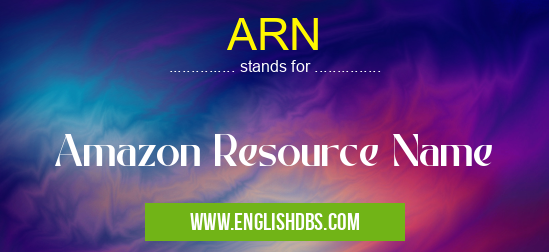What does ARN mean in GENERAL
An Amazon Resource Name (ARN) is a unique identifier used to identify an entity, such as an Amazon EC2 instance, in the Amazon Web Services (AWS) world. They are used to provide access to various AWS services and resources, while also helping maintain security and control. ARNs make it easy to set up and manage resources across multiple services.

ARN meaning in General in Computing
ARN mostly used in an acronym General in Category Computing that means Amazon Resource Name
Shorthand: ARN,
Full Form: Amazon Resource Name
For more information of "Amazon Resource Name", see the section below.
What is an ARN?
An Amazon Resource Name (ARN) is a string that uniquely identifies a resource within the AWS platform. It functions like a universal addressing system for all resources, allowing them to be identified regardless of their region or service type. The format of an ARN consists of a specific set of components that are virtual building blocks for creating an effective Amazon identity structure for use with APIs, SDKs, and other tools for managing AWS resources. Specifically, each component of the ARN must include the following elements: • Partition — this component specifies which AWS product the resource belongs to; • Service — defines which service the resource belongs to; • Region — this component specifies which AWS Region the resource resides in; • Account ID — this component identifies the account that owns the resource; • Resource Type — this element specifies what kind of resource it is; and • Resource Path — this component describes which specific resource is being identified by the ARN.
Benefits & Uses
The primary benefit of an ARN is its ability to provide quick access to multiple AWS services and resources across different regions and accounts. With an ARN, you can easily create, secure access control lists (ACLs), query databases, send messages between services, manage user accounts, execute commands on remote systems and much more. In addition, they enable you to specify precisely which resources should be affected when making changes related to security or management tasks. This level of granularity makes it easier to ensure that your intended action will take place without unintentionally altering any unwanted resources or settings.
Essential Questions and Answers on Amazon Resource Name in "COMPUTING»GENERALCOMP"
What is an Amazon Resource Name (ARN)?
An Amazon Resource Name (ARN) is a unique string of characters used to identify a specific resource within the Amazon Web Services (AWS) platform. It identifies the type and name of resources, such as an EC2 instance or an S3 bucket, allowing for resource access control and auditing.
What information does an ARN contain?
An ARN contains four main components that provide details about the resource. These include the partition, service, region and resource type. For example, "arn:aws::s3::region/bucketname/keyname" represents a specific object in an S3 bucket in a particular region.
How can I generate an ARN?
You can generate an ARN by going to the AWS Management Console and selecting your desired resource. A pop-up window will then appear containing your generated ARN.
Where can I find my ARNs?
You can find your list of ARNs in the AWS Management Console under Identity & Access Management > Policies > Policy Documents section.
Is there any way to determine which resources are associated with my given ARN?
Yes, you can use the DescribeResources command from AWS CLI using the --filters argument for filtering out by specific elements of your target resources' attributes - such as their tag names or other identifying elements — based on their corresponding values in order to retrieve data about them from your account's inventory list.
How long does it take for changes to be reflected after making changes to my policy document?
Generally speaking, changes made to existing AWS policies will take effect immediately; however, there may be some lag time between when you make changes and when they show up in other parts of your account due to propagation delays across different services within AWS.
Can I create custom ARNS?
No, custom ARNs cannot be created directly but they can be derived from existing ones through substitution or addition of certain parts like namespaces and identifiers. Custom policies could also be created using these methods.
What kind of permissions do I need to edit my policy documents?
To edit policy documents you must have "AdministratorAccess" or "IAMFullAccess" privileges on your AWS account in addition to explicit permission for each action that requires elevation (see ListPolicies).
Final Words:
In summary, Amazon Resource Names (ARNs) are essential for getting the most out of your cloud-based infrastructure on AWS. By providing consistent identifiers for all your resources regardless of their region or service type, they help maintain security controls while making it easier to manage everything from individual machines through large-scale deployments spread across multiple accounts and regions. Properly leveraging them can save time as well as reduce potential problems caused by unintended consequences related to incorrect changes or access restrictions.
ARN also stands for: |
|
| All stands for ARN |
